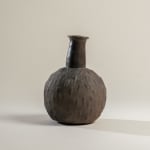Chavin Culture 1200 BC-400 BC
Black Ware Gourd Vessel, Circa. 800 - 100 BC
Ceramic
22 cm high
8'6" in. high
684 grams
8'6" in. high
684 grams
CHAV0013
Copyright of Paul Hughes Fine Arts
The bottle-shaped vessel with a narrow neck and flared rim is characteristic of utilitarian and ceremonial ceramics in the Andes. Such vessels were often used to store chicha (a fermented...
The bottle-shaped vessel with a narrow neck and flared rim is characteristic of utilitarian and ceremonial ceramics in the Andes. Such vessels were often used to store chicha (a fermented maize drink), water, or other liquids, and were sometimes buried as grave offerings in elite tombs. The rounded body and narrow spout also suggest it may have been used in libation rituals, where liquids were poured out as offerings to deities or ancestors.
The dark burnished surface and the slightly metallic sheen suggest reduction firing, a method commonly used in Andean pottery to produce blackware. This technique deprives the kiln of oxygen, causing the clay body to darken—a method still used in traditional pottery communities such as those in the highlands of Ecuador and southern Colombia.
The incised, almost punctate texture decorating the body is a notable feature. These patterns could be interpreted as abstract representations of agricultural or natural forms—perhaps maize kernels, feathers, or even rainfall—elements that hold deep symbolic value in Andean cosmology.
The dark burnished surface and the slightly metallic sheen suggest reduction firing, a method commonly used in Andean pottery to produce blackware. This technique deprives the kiln of oxygen, causing the clay body to darken—a method still used in traditional pottery communities such as those in the highlands of Ecuador and southern Colombia.
The incised, almost punctate texture decorating the body is a notable feature. These patterns could be interpreted as abstract representations of agricultural or natural forms—perhaps maize kernels, feathers, or even rainfall—elements that hold deep symbolic value in Andean cosmology.









